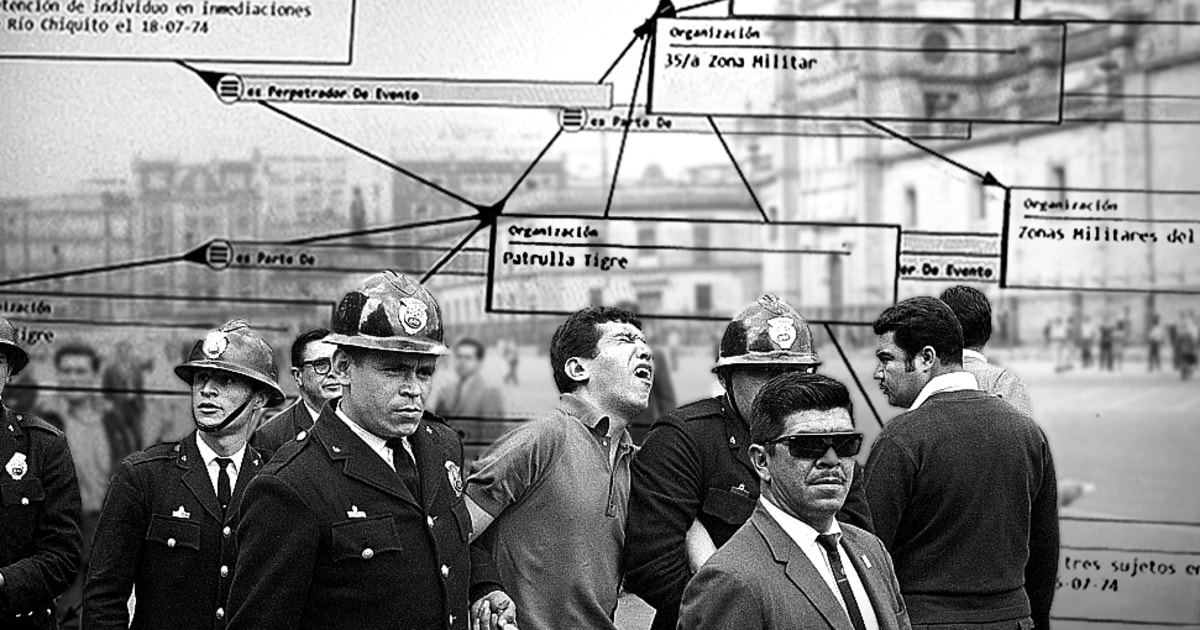MEXICO CITY.- In a country with around 110,000 people reported missing, finding some of them now could be just a few clicks away.
That is the slogan and the hope behind
Angelus 2.0, a computer program
that is being developed by a Mexican government institution created four years ago.
Operating from a generic office in the south of the capital, on the seventh floor of a building filtered with noise from the traffic below and hunched over their computers, the team has been developing the program since 2019.
While the groups of relatives and mothers of disappeared persons have had to perfect ways of digging the earth throughout the country to see if they can thus find traces or remains of their loved ones, the Angelus runs in that office.
It was intended to digest thousands of documents and databases from which a computational eye can
find connections and patterns
that elude the human eye
, which it then presents in a visual set of links.
And with this, perhaps the algorithms can reveal the whereabouts of someone or refine where it is that it is necessary to dig.
“We are producing relevant evidence to locate tens of thousands of disappeared people,” historian Javier Yankelevich, a soft-spoken 34-year-old academic who at moments of the interview was visibly moved, almost wanted to cry, told Telemundo News. that your work involves given the cases you investigate.
He is a member of the National Search Commission, the state agency dedicated to clarifying the whereabouts of missing persons.
[Every day 26 people disappear in Mexico; in 2022 more than 16,000 cases were recorded]
“This is the type of response that is needed,” adds the researcher, who leads the team that has been working on the program for about three years within the CNB, together with academics from the National Council of Science and Technology (Conacyt).
"With the new technologies that we are trying to develop," adds Yankelevich, "
we can achieve the results
that people are expecting."
And it is that many have been waiting for decades;
On January 10, they demonstrated asking for more progress in the investigations.
For now, Angelus is focused on reviewing what is known about people who were forcibly disappeared
between 1964 and 1985
, part of a particularly dark period in recent Mexican history —dubbed the Dirty War or counterinsurgency— in which authorities and groups linked to the Revolutionary Party government Institutional (PRI) repressed and persecuted with systematic violence those they considered "disruptors" or insurgents.
Where was a missing person, say Juan Perez, last seen at that time?
Perhaps someone who survived the clandestine government centers testified in another case that he recalls that someone named Juan Pérez was in the same cell.
Then Angelus, capable of reviewing a mountain of documents, could make the link... and, when Juan's trail seemed lost, show a next clue.
A 2001 march by relatives of people who disappeared during the counterinsurgency period in MexicoJorge Uzon/AFP via Getty Images
Little by little, those
in charge of doing justice begin to take notice
, after many months of frustration from Yankelevich and his team when they did not.
The historian says that around November they were first contacted by a unit of a state prosecutor's office, asking how they could use Angelus to find information relevant to their cases.
The Angelus of Mexico could even lay the foundations so that in Guatemala, Colombia, Chile —in
all those countries
where regimes, dictatorships or paramilitaries also perpetrated disappearances and crimes in a massive and systematic way— a similar technological tool brings the victims closer to justice .
When the number of individual cases overwhelms the number of detectives by such magnitude, these other ways become crucial.”
javier yankelevich
"The central question in the search for people is
where
, and the where are not individual in these cases," says Yankelevich, indicating that "if we do not manage to generate a methodological level that transcends individuality, we will never solve it."
digital brainstorming
Angelus is designed to form graphs, a kind of
visual network
that shows all the connecting lines between missing persons, perpetrators, and places.
With this, you can see relationships and coincidences, such as in which clandestine site three people ended up who did not seem to have any other link between them.
A look at one of the graphs of the AngelusNoticias Telemundo program
Behind the program there is a
multidisciplinary
team
: historians, archivists, computer scientists, biologists, lawyers, internship students.
All collaborating with their grain of sand to develop the program, review documents, feed them to the Angelus and monitor what is starting to come out.
With Angelus, it was possible recently to "have a couple of clicks away" enough information, says Yankelevich, to contact survivors of one of the largest clandestine counterinsurgency centers, Campo Militar no.
1. Last September, these survivors were invited to tour the military site, which covers thousands of square kilometers and is still in operation as a military court site, to carry
out acts of recognition for the first time
, such as confirming sketches and identifying specific spaces where violence was committed. so that forensic analyzes can be more accurate.
Arrest of a person in Mexico City in the fall of 1968. Photograph by Bettmann Archive via Getty Images.
Photo illustration by Juliana Jiménez/Telemundo News
More ground is opening for such events now that prosecutors are just beginning to show interest, something a visibly frustrated Yankelevich says "it's been very difficult ... although I can't understand why they wouldn't want to" use the information.
That aspect of his job is "
swimming against the current,"
he summarizes.
[This mother received only "bits" of her missing daughter. She is still searching for the truth and she is not alone]
"To the extent that you find the victims of forced disappearance, you will find useful information to do justice. And to the extent that you do justice, you will find useful information to find the victims," summarizes the historian.
To date, only one agent has been prosecuted and convicted for the disappearances during the Mexican counterinsurgency.
The impact of technology
It is not the first approach of technology to address the problem of disappearances in Mexico.
In recent years NGOs such as the Data Cívica group have also compiled databases;
for example, one about the locations of clandestine graves or one that managed to link the pages of recent disappearances with the identity of that person to name the numbers.
In other countries, technological programs have also been used to clear up cases.
In the United States, for example, there are
hackers
who study
information from open sources
to help the authorities, especially in cases of missing children;
They look to see if someone with features like the missing person can be seen in the background of a photo someone shared on Instagram with geolocation.
And agencies like the FBI have forensic data (fingerprints or facial identification).
Worldwide, the Forensic Anthropology group uses social media posts as well as videos to reconstruct events and clarify what happened.
One of the group's investigations, in collaboration with Mexican NGOs, was about the disappearance of 43 students from Ayotzinapa in September 2014. In South America, the Argentine Forensic Anthropology Team —which has spent four decades searching for those who disappeared from the dictatorship— has begun incorporating drones and Lidar, laser technology, to scan land and water for possible debris.
However, the fact that Angelus comes from the State sets it apart: it is
an entire program created from scratch
, instead of using existing tools, specifically for people search.
Working on it from the Government gives more
institutional visibility
to the search for the truth (what happened, who committed it, where the victim ended up) and, with it, a greater opportunity for families and survivors to access justice: it seems less likely tax authorities to ignore proofs and evidence when collected by other branches of government.
"These people have been missing for more years than I have been in the world and we are not the first to try [to elucidate the whereabouts]. However, we are the first, a new generation, to put technological tools
of this
kind at the service of this mission
. nature," says Yankelevich.
"When the number of individual cases overwhelms the number of, say, available detectives by such magnitude, these other ways become crucial."
Know history so as not to repeat it
Today there are hundreds of boxes
with thousands of documents each
on the actions of authorities in the counterinsurgency, partially declassified and accessible in the collection of the General Archive of the Mexican Nation.
Youths arrested on October 3, 1968 in the repression of protests in Tlatelolco, Mexico City.
Hundreds of people went missing on those dates.Bettmann Archive via Getty Images
In these documents, he realizes how the perpetrators—largely the General Directorate of Political and Social Investigations, and the Federal Security Directorate, agencies that spied on and detained those they considered to be dissidents—used to repeat their
modus operandi.
“The same vehicles, weapons and places of clandestine detention” against “the same type of victims, victimized for the same reasons,” summarizes Yankelevich.
Mostly
young people,
students, teachers and teachers (some gathered in groups and associations) who protested and called for democratization.
This systematicity implies, according to the researcher, that "the cases cannot be seen individually because the destinations are not individual."
Several people were probably tortured at one point by the
same officer using the same nickname while in the same location
, for example.
Hence, an Angelus is key to better elucidate these patterns.
["I saw how they cooked your brother." This is how the kitchens work where the drug traffickers disappear their victims]
Though feeding Angelus is hard work.
It has involved devising the development of algorithms and doing
machine learning
so that the program identifies when the same names appear even if the last name does not have the tilde in a document.
As well as reconcile the different disciplines of those who make up the team, and appeal to the authorities and prosecutors to join the technological effort to use it as evidence in their criminal proceedings.
But, on top of that, the work behind Angelus involves for some devoting themselves almost daily to reading documents and records written by
agents detailing his atrocities
;
how they tortured, beat, raped, disappeared and what tools or, in particularly bloody cases, live animals they used to commit violence.
keep giving battle
The Angelus team knows that just because the work is difficult, they need to keep doing it.
We are the first, a new generation, to put technological tools of this nature at the service of this mission."
The work has an impact on the victims, those who remain missing and those who are located.
You can give answers to families.
It also "may have a broader projection", in the words of Yankelevich: continue to demonstrate even so many years later that this type of violence is
unacceptable and inadmissible
regardless of what motivated the actions of the agents.
“So you feel that you are part of a movement
towards a slightly more civilized society
,” says the historian.
It's also why at some point this year they want to make a version of the program code public, taking advantage of the fact that since it was made from scratch there is no intellectual property component of the software that prevents them from sharing it.
Protests and claims for the disappeared in the heart of Mexico City
Aug 31, 202201:47
"We are legally in the possibility and of course in the desire that whoever this serves can use it," says Yankelevich.
That in other parts of Mexico, in other parts of Latin America and far beyond, he says, "people with computer profiles can adjust it and make the program do specifically what they need it to do."
Perhaps this way, Angelus will be able to grow and improve more and more, until reaching a version where he not only puts together graphs for the period of the counterinsurgency, but also about disappeared persons at the hands of the
current criminal groups
that systematically violate the inhabitants of towns disputed by Mexican cartels or migrants in transit from Central and South America.
In this way, Angelus will honor the origins of its name, a painting by Paul Klee that shows the "angel of history": a creature that knows that, in order to build our future, we also need to look at the past.















